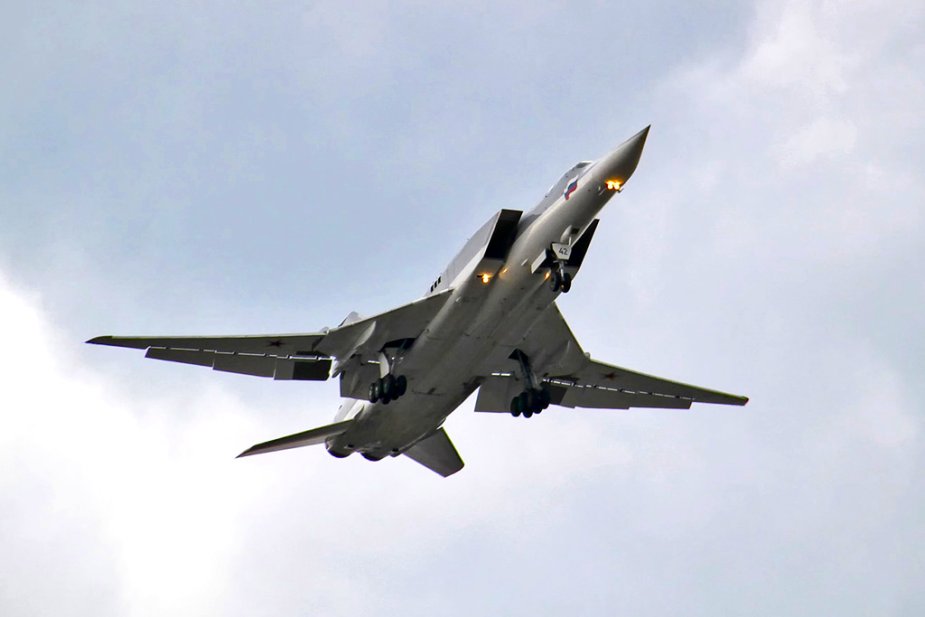The Russian Air Force Tu-22M3 bomber will probably be able to carry the Kinzhal hypersonic missile. The new carrier will undergo trials with Kinzhal, a sure in the Russian military-defense complex told TASS. "Kinzhal will be tested on Tu-22M3," the source said and specified that several hypersonic missiles will be tested on one bomber. TASS could not obtain official confirmation of the report.
 A Tu-22M3 strategic bomber delivered on April 4, 2018, to Russian Air Force
A Tu-22M3 strategic bomber delivered on April 4, 2018, to Russian Air Force
(Credit: Tupolev)
In Soviet times Tu-22M3 were armed with aeroballistic Kh-15 missiles (type 115) capable of hitting stationary ground targets and air defense at a distance of 300 km. The basic missile option had a nuclear charge and inertial non-adjusted targeting system. Antiradar Kh-15P missile with passive adjustment aiming by radar beam from the target and armed with high-explosive fragmentation warhead was developed. Kh-15S had an active targeting adjustment system, maximum launch range varied from 60 to 100 km depending on target size. Kh-15 missile family could operate at altitudes of 300 - 22000 meters. Maximum speed was Mach 5, circular error probability - 5-8 m.
Kh-15 trials on Tu-22M3 began in late 1970s. In 1980s batch production was launched. Besides Tu-22M3, the missile could be carried by strategic Tu-160 bomber. Open sources said the aircraft could carry up to 24 Kh-15 missiles accommodated on multi-positional catapults MKU-6-1 inside two compartments. Tu-22M3 could carry up to 10 Kh-15 inside the fuselage on MKU-6-1 (six units) and on outside suspension PU-01 (four units). Kh-15 have been decommissioned at present.
Aeroballistic hypersonic Kinzhal was announced by President Vladimir Putin in March. The missile flies ten times faster than the speed of sound and can break through all existing and prospective air and missile defense. The Kinzhal complex includes MiG-31K aircraft which can carry only one missile under the fuselage. The Defense Ministry said there are currently 10 operational MiG-31K. They differ from MiG-31BM/BSM. The under-fuselage AKU-410 catapults to launch air-to-air long-range R-33 missiles were partially dismantled and under-wing suspensions for guided air-to-air short and medium-range missiles were pulled down. GLONASS sensor was installed in the front and the lower fuselage was adapted to carry Kinzhal.
Russian and foreign experts believe Kinzhal missile has been likely created on the basis of guided operational-tactical 9M723 missile or its upgraded 9M723-1 option of Iskander-M missile complex. Iskander-M range is limited by the INF Treaty and comprises close to 500 km. A missile carried by a supersonic aircraft can considerably increase the range. Experts estimate Kinzhal range at 2000 km. 500-700 km are the radius of MiG-31K aircraft, 1300-1500 km are the range of the aeroballistic missile. It is launched from an altitude of 15-20 km at a speed of Mach 1.5-2.
Open sources said Kinzhal considerably surpasses Kh-15 by weight and size. Various Kh-15 modifications were 4.5-4.78-meters long and the diameter was 0.45 meters, wing span - 0.92 meters and weight of 1100-1200 kg. According to preliminary estimates, Kinzhal is close to 8-meters long, the diameter is slightly less than one meter and the weight is close to 4 tons. Thus, it is impossible to launch it from MKU-6-1 from inside Tu-22M3 fuselage. It is also unlikely that the missile can be fired from outside PU-01 suspension located under the fuselage of the carrier.
Thus, Kinzhal is close to Kh-15 by designation and class, but it approaches Tu-22M3-carried antiship Kh-22 and the latest Kh-32 by weight and size. Kh-22 is 11.65 meters long, has a 0.9-meter diameter, wing span of 3.0 meters and weighs 5.6-5.7 tons. Kh-22 and Kh-32 missiles are carried on two under-wing suspensions BD-45K and one extendable holder BD-45F of the under-fuselage suspension in a semi-recessed position.
The Tupolev Company said maximum Tu-22M3 speed is 2000 km/h. Tactical range is 2200 km at subsonic speed and practical ceiling is 14000 meters. Open sources give no data on Tu-22M3 maximum speed and range with three suspended Kh-22 antiship missiles. One can only suggest the speed with three suspended missiles does not exceed 1600-1800 km/h which is much less than MiG-31K can develop. Bigger fuel reserve (53550 kg of Tu-22M3 against 16350 kg of MiG-31K) helps Tu-22M3 fly longer at supersonic speed and thus increase Kinzhal range. It means Kinzhal range on the new carrier can be also close to 2000 km. But Tu-22M3 will face bigger threat as it will have to approach adversary air defense closer than MiG-31.
The above-mentioned facts make it highly likely that each Tu-22M3 will carry three Kinzhal missiles on outside suspensions. It will allow salvo fire at air and missile defense, aircraft carriers and warship formations, infrastructure and other large area targets. The engagement of Kalibr against warships armed with modern combat information and control systems, such as Aegis, will be more efficient than Kh-22 or Kh-32.
There are many questions related to Tu-22M3 modernization for Kinzhal. It is possible the aircraft will have to be upgraded to Tu-22M3M level. The first flight of the upgraded aircraft is expected in August 2018. Kinzhal is likely to be tested on it.
At the same time it is necessary to continue MiG-31K supplies to the Russian Aerospace Forces. Open sources estimate MiG-31 stocks at close to a hundred. Their upgrade to MiG-31K will allow arming western and southwestern units of Aerospace Forces with Kinzhal. It is logical to believe MiG-31K with Kinzhal will target air and missile defense and military infrastructure while Tu-22M3 would fight groups of warships.
The Military Balance 2018 publication said Russia has 61 long-range Tu-22M3 bombers. It is unclear how many aircraft can be upgraded to Tu-22M3M, but experts believe 20-30 aircraft will be modernized to carry new bombing SVP-24-22 equipment and NV-45 radar. They will have better cockpit ergonomics, new onboard systems and the glider resource will be extended to 35 years. Tu-22M3M will get a completely new targeting complex. It will be able to engage modern long-range precision weapons. The power plant will be identical to that of Tu-160M2 (NK-32-02 engines produced by the Kuznetsov enterprise in Samara).
Modernization time and the number of upgraded aircraft will depend on enterprise capacity and how successfully the first aircraft are upgraded. TASS reported in May that Tu-22M3M with the latest supersonic Kh-32 long-range cruise missile will go on combat duty in the long-range aviation in October 2018.






















